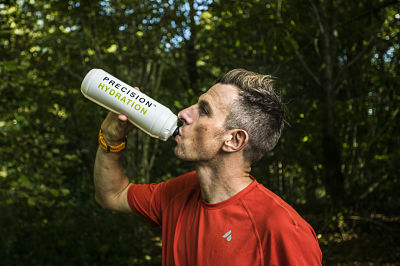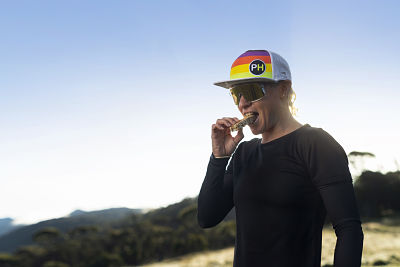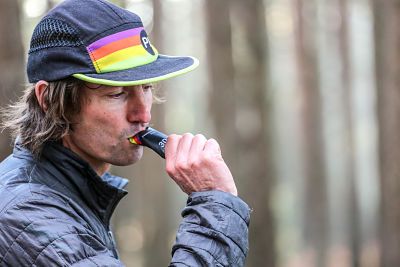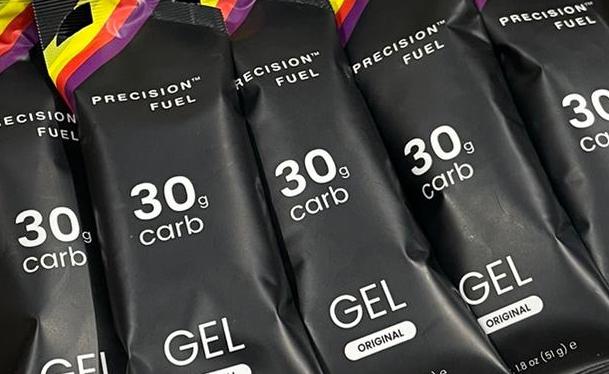We get it. You’re wondering why a company originally called Precision Hydration is talking to you about fueling. To really understand why it makes total sense, you need to know how we've evolved over the years…
Why we got into hydration and how Precision Fuel & Hydration evolved
We got into the performance hydration business after our co-founder Andy’s hydration issues led him to discover and take a sweat test.
That confirmed his suspicions that he was a very salty sweater so he was able to get on top of his problems with cramp and hyponatremia (low blood sodium levels) by replacing more of the electrolytes he was losing in his sweat before and during hot races.
He saw first-hand how impactful understanding your individual needs could be to your performance and so set out to…
a) make sweat testing more widely accessible and b) spread the word that a one-size-fits-all approach to hydration doesn’t cut it.
When we launched back in 2011, we didn’t have a range of electrolyte supplements in different strengths to match how you sweat, we simply Sweat Tested athletes and helped them use the knowledge of how much sodium they lose in their sweat to refine their hydration strategy using existing products on the market.
We built the first versions of our Sweat Test and Online Sweat Test software and used our expertise and experience to help athletes dial in their hydration plan using what was already available through trial and error.

But almost immediately we realised that knowing your numbers was only really useful and impactful if you could easily hit them when it mattered in training and racing.
The first problem was that most electrolyte drinks and tablets were not strong enough for even the average endurance athlete, let alone heavier and saltier sweaters like Andy.
The packaging most hydration products came in didn’t help either. There wasn’t (and still isn’t) a standard way to display the sodium content of a drink, tablet or drink mix. Most products quote the amount of ‘Salt’ per serving, which is misleading as the salt in a product is typically in the form of sodium chloride, which is actually only 39% sodium (with the other 61% being chloride).
So, 1g of salt in a product contains only around 390mg of sodium, not 1,000mg. Sodium is the most important electrolyte when it comes to staying hydrated and it’s easy to see how an athlete might underdo their intake despite paying a keen interest in the nutritional tables on the back of the packet.
So, we launched a range of electrolyte tablets in different strengths (the strongest being PH 1500, which has around 3x the sodium of a typical sports drink) and we put the relative sodium concentration per litre on the front of the packaging as big as we could. This made it really easy to find the right strength for you based on your Sweat Test results. It also helps you accurately track how much you’re taking in during a race.
Other formats (all-natural drink mixes and blister-packed capsules) followed in subsequent years as we discovered that different product types had different use cases and that athletes had individual preferences.
Fueling was always a part of the conversation
Fast forward to 2021 and we’d helped over 80,000 athletes nail their hydration strategy using our tools, expertise and products.
Since the beginning almost every conversation about what to drink to stay hydrated inevitably included a discussion of what to eat to stay properly fueled.
There’s an obvious overlap, with many sports drinks delivering some energy and many energy products containing a small amount of electrolytes. People naturally wanted to know what to eat when they were drinking our electrolytes.
But it went deeper than this. We were helping athletes work out what their individual fluid and electrolyte needs were, but for many of them there was a lack of clarity on how much fuel they needed to perform at their best.

That’s partly because brands typically focus more on the ingredients, formulations and flavours that differentiate their product in a crowded marketplace than the more important topics of how much of it to use and when it makes sense to use it (and, perhaps more importantly, when it might not!).
Being optimally hydrated can only be so impactful on your performance if you bonk because you’re not getting enough carbohydrate in to fuel your efforts.
One of the things we’re very proud of is the length our team goes to help any athlete who reaches out looking for support as they strive to achieve their potential. Whether you buy our stuff or not, our experienced team (we’re athletes too) is always at the end of an email or ready to hop on a free video call. We’ll help you answer any questions you have about performance, not just hydration. So, we’ve actually been helping athletes understand their fueling needs on a one-to-one basis for a while now.
We often ask athletes to tell us everything they plan to (or did) consume during a race so we can analyse this and give them advice on their strategy. We can be quite obsessive over this. The other day I overheard Abby and Brad debating the size of the pizza slice Brad had eaten during a pit stop on a 200-mile ride so that Abby could get his total carb intake recorded as accurately as possible...
You’ve probably noticed some of that work in our email newsletters over the years, as we often share it because it can be really helpful to see how other athletes are approaching fueling and hydration when you’re working on your own strategy.
Over time we realised that it would be incredibly useful to create a suite of tools to help athletes understand how much fuel they need, just like we did with hydration. So, we got to work on understanding the science of fueling in more detail, creating early versions of the tools in Excel and using them with athletes to help us improve them.
Subsequently, we've refined the tools we've developed behind the scenes. Having our usual commitments reduced by the COVID-19 pandemic gave us the space to consider a push to make these available to you alongside our resources in hydration. It seemed like a natural next step.
What is also interesting is the way that the conversation around fuelling is coming into line with that of hydration. We introduced the concept of a personalised hydration plan many years ago. Now we are seeing tools such as Continuous Glucose Monitors (CGM) from companies such as SuperSapiens coming to the market.
If you want to use these nutrition tools, we want to be there for you with a line of products and straightforward advice that replicates what we have done in the hydration space.
Introducing Precision Fuel™
Hydration is a fairly contentious issue in sports science, but dare we say it, there’s more consensus on how much carbohydrate athletes need per hour.
We combined what the science says with our extensive data and practical experience from working with professional and amateur athletes for 10+ years and launched our first tool to help you understand your fueling needs...
It’s called the Fuel & Hydration Planner and it’s designed to help you quickly work out how much carbohydrate (the primary fuel source when it comes to endurance exercise), sodium and fluid you need per hour in different scenarios.

We’ve written a full piece on why understanding how much fuel you need should be your number one priority when it comes to creating a fueling plan, so I won’t repeat that all here, but it really is the key to getting fueling right. Underfueling and overfueling are two of the most common mistakes we see when working with athletes.
As we were developing these tools, we realised that what’s true for the sports drink industry is also true for the energy product market. There’s very little guidance from sports nutrition brands on how much of their product you need to take in to maintain your performance and it’s often very difficult to work out exactly how much carbohydrate you’re getting from a given gel, drink, bar, chew, or a combination of them all.
The back of the packaging might tell you the carbohydrate content per 100g and per serving, but then the usage advice is something vague like “Take one to three servings per hour during exercise, less if you're also using a sports drink.” (That’s a real example!). Not very helpful at all.
That’s why, alongside the new tools, we’re launching a range of fueling products that will replicate what has been so successful with our electrolyte range. Namely, we’ve put the carb content per serving smack bang on the front of the packet in big letters. We’re starting with a gel (PF 30 Gel) and an energy drink mix (PF 60 Energy Drink Mix). Other formats will follow to suit different scenarios and individual preferences. You can learn more about how to choose the right energy product for your needs here.
Since writing this blog, the two products we started with have recruited quite a few more friends! We still offer the PF 30 Gel (plus a caffeinated version and a 90g Gel), but the PF 60 Energy Drink Mix is now the Carb & Electrolyte Drink Mix. For big efforts with high carb targets, try the PF 300 Flow Gel or the Carb Only Drink Mix.

Introducing Precision Fuel & Hydration
The fact we're now fueling and hydrating athletes led to a discussion about our name...
So, as of January 2022, we rebranded as Precision Fuel & Hydration. It does exactly what it says on the tin.
As with hydration, we believe our tools and advice are the most important thing we offer and they’re available to everyone for free. We’re experienced athletes and practitioners, so we think we’ve developed some really nice energy products but, at the end of the day, we’ve done so primarily to make it easy for you to put your fueling plan into action once you’ve got a handle on your numbers. The fact that we think they are easy on the stomach and taste fantastic is a bonus!
We hope you find our new tools and products genuinely impactful as you work to hone a fueling strategy that helps you perform at your best. If you have any questions at all, we’re here to help and we definitely want to hear your feedback as we continue to develop these new aspects of our service.
